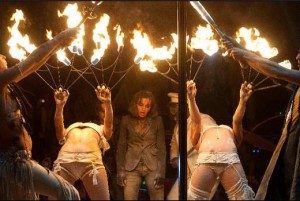The Burning Man Festival is a week-long event held every summer in the Black Rock Desert of northern Nevada. It is an experiment in community, self-reliance, and self-expression. Each year over 50,000 people make the journey to the desert to form a temporary city known as Black Rock City, a community of art, co-dependence, and spirituality. Attendees to the event must bring all their own food, water, transportation, and anything else they would like to contribute to the community. Monetary transactions are not allowed within the confines of the festival; all exchanges must be bartered or gifted. At the end of the week the festival concludes with the burning of a giant wooden effigy, hence the name “burning man.” One of the primary tenets of the festival is to “leave no trace,” and once concluded attendees are required to clean up all their garbage and leave the desert in exactly the pristine condition in which it was found.
Burning Man started in 1986 on Baker Beach in San Francisco, when friends Larry Harvey and Jerry James built an 8-foot statue of a wooden man and lit it on fire as a form of radical self-expression. From then on, each year the event grew bigger and bigger, and with the help of more people so did the statue. By 1988 the statue had reached 40 feet, a height that has remained fairly consistent until today. In 1990, police had intervened with the burning of the statue stating that beach campfires could only reach 3 feet in height. With the help of Michael Michael and John Law of San Francisco’s Cacophony Society, it was decided to move the event to the Black Rock Desert of Nevada, a dry lake bed known as a playa.
In the 90s as the event grew in popularity, new rules and restrictions had to be put into effect for the safety of the participants. Driving, except for approved “mutant vehicles,” was banned to keep the event pedestrian and bicycle friendly. There was also a speed limit of 5 mph enforced, a ban on firearms or fireworks, and a ban on dogs. Furthermore, the larger attendance to the event forced a grid-like street structure to be formed, as well as a perimeter fence originally called the “trash fence,” to catch any debris swept up by the desert winds.
Today the event has grown to unimaginable numbers, making temporary Black Rock City the 7th largest city in Nevada for 1 week every year. Each year tens of thousands throng to the desert in outrageous outfits (or lack of outfits for that matter), body paint, and make-up to be accepted, embraced, and nurtured in a completely self-reliant community. They come to sing, dance, communicate, and cooperate. And although many things have changed from its origination, Burning Man still follows its innate mission of inclusiveness, community, expression, and giving.
Zen Arts was fortunate enough to have performed at Burning Man in 2010. Hopefully in 2011 as well. We’ll let you know.


